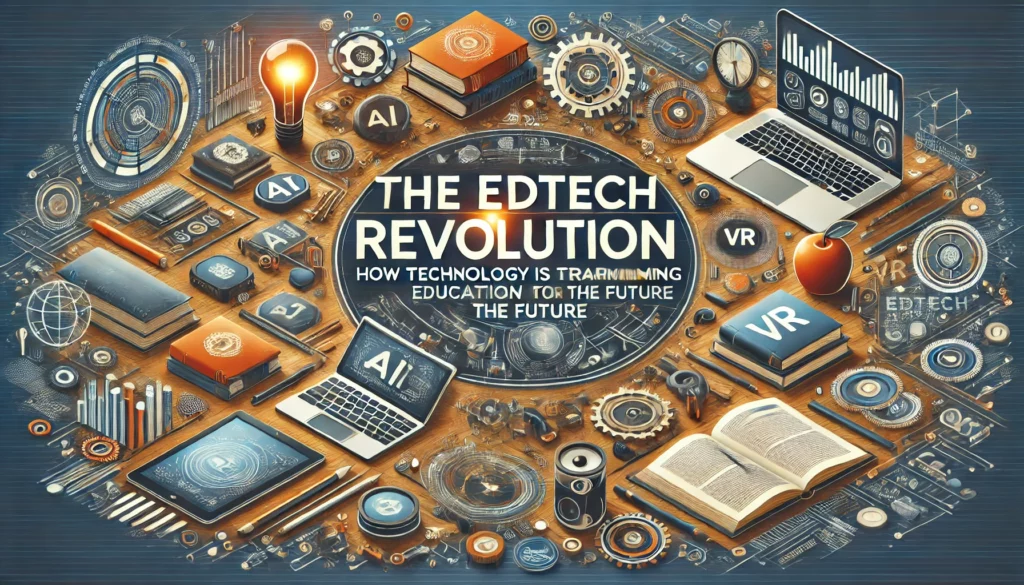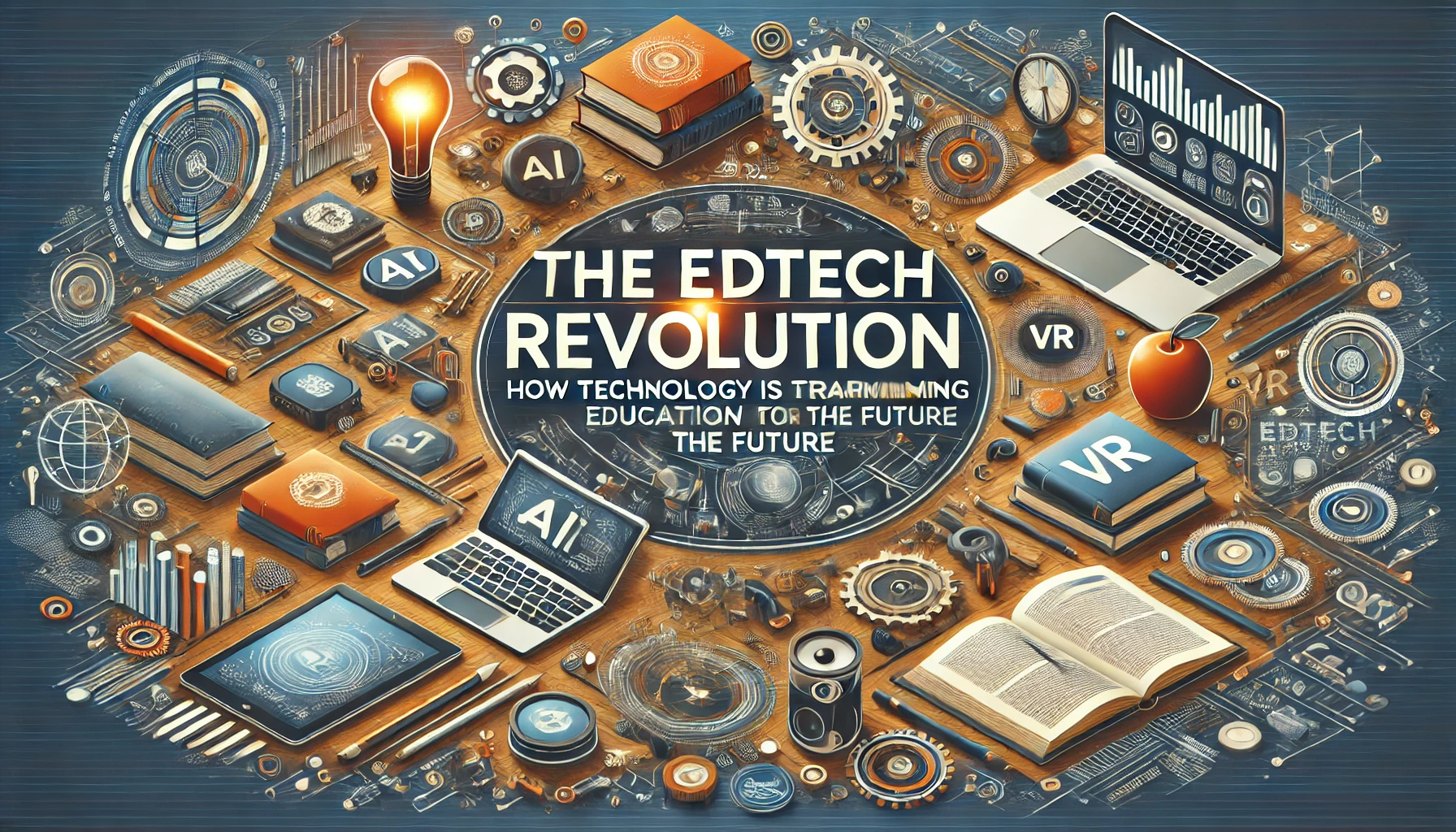
EdTech revolution, the landscape of education is changing rapidly. With advancements in technology, the traditional classroom model is being reshaped by EdTech (Educational Technology), creating new possibilities for learning and teaching. This revolution is not just about replacing old tools but about reinventing the very process of education to better prepare students for the future. In this article, we’ll explore how technology is transforming education and what that means for the future of learning.
Introduction: What is the EdTech Revolution?
The EdTech revolution refers to the integration of technology into the education system to enhance learning experiences, improve educational outcomes, and make education more accessible. This shift has been accelerated by the increasing use of digital devices, online platforms, and innovative software solutions that support both teaching and learning. EdTech is paving the way for a more personalized, flexible, and efficient approach to education.
Why Technology is Essential for the Future of Education
Technology plays a critical role in the evolution of education. Here’s why:
1. Accessibility and Reach
With the internet and digital tools, education is no longer confined to traditional classrooms. Students from remote areas can access quality educational resources online. Whether it’s virtual classrooms, video lectures, or e-learning platforms, technology bridges geographical barriers, making learning accessible to a global audience.
2. Personalization of Learning
One of the most significant advantages of EdTech is its ability to cater to individual learning needs. Adaptive learning technologies allow students to progress at their own pace, offering customized resources and feedback based on their strengths and weaknesses. This ensures that every student can learn in a way that suits their personal style.
3. Data-Driven Insights
Through data analytics, teachers and administrators can gain valuable insights into student performance. By tracking metrics such as time spent on tasks, completion rates, and test scores, educators can make informed decisions about curriculum adjustments, identifying areas where students need additional support. This data-driven approach enhances teaching effectiveness and student outcomes.
Key Technologies Driving the EdTech Revolution
Several technologies are reshaping education and playing a pivotal role in this transformation. Let’s dive into the most influential ones.
4. Artificial Intelligence (AI)
AI is revolutionizing how students learn and how educators teach. AI-powered tools can automate administrative tasks, provide personalized learning experiences, and even assess students’ understanding. Virtual tutors, intelligent grading systems, and chatbots are examples of AI in education, making learning more engaging and accessible.
5. Virtual and Augmented Reality (VR/AR)
Virtual and augmented reality offer immersive learning experiences. In VR classrooms, students can explore historical events, visit different parts of the world, or even practice complex surgeries. AR, on the other hand, overlays digital content in the real world, helping students visualize complex concepts like the human anatomy or architectural designs.
6. Learning Management Systems (LMS)
Learning management systems are platforms that help teachers deliver educational content online. They facilitate the distribution of materials, assessments, and feedback while also providing collaboration tools. Popular LMS platforms include Google Classroom, Moodle, and Blackboard, which allow educators to manage and track students’ progress efficiently.
7. Gamification
Gamification uses game-like elements, such as point systems, rewards, and challenges, to make learning more fun and engaging. By incorporating competition and interactive tasks, students are motivated to actively participate, leading to higher engagement and better retention of knowledge.
The Role of Mobile Technology in Education
8. Smartphones and Tablets
With the proliferation of smartphones and tablets, education has become more mobile and accessible. Students can now study on-the-go, access e-books, watch instructional videos, and participate in online discussions from their devices. Mobile learning has broken down the traditional boundaries of classroom time and location.
9. Mobile Apps for Education
There are numerous mobile apps designed specifically for educational purposes. These apps cover everything from language learning to mathematics, programming, and even mindfulness. They provide students with tools to learn at their convenience, turning any location into a potential learning space.
Online Learning: Changing the Way We Learn
10. The Rise of MOOCs (Massive Open Online Courses)
MOOCs have revolutionized higher education by offering free or affordable courses from top universities and institutions. Platforms like Coursera, edX, and Udemy provide opportunities for lifelong learning, allowing individuals to access high-quality education at their own pace, regardless of location.
11. Blended Learning Models
Blended learning combines traditional classroom instruction with online learning. This model offers flexibility, allowing students to benefit from face-to-face interaction and the convenience of online resources. The combination of both methods creates a richer learning experience.
12. Flipped Classrooms
In a flipped classroom model, students learn new content at home through videos and online resources, and class time is reserved for discussions, problem-solving, and collaborative activities. This method promotes active learning, making class time more engaging and allowing teachers to provide personalized support.
The Impact of EdTech on Teachers and Educators
13. Empowering Teachers with Technology
Technology isn’t just beneficial for students—it also supports teachers. EdTech tools streamline administrative tasks, enhance lesson planning, and provide professional development opportunities for educators. Teachers can use technology to stay up-to-date with the latest teaching methods, collaborate with colleagues, and engage their students more effectively.
14. Continuous Learning and Professional Development
Teachers can now access online courses, webinars, and workshops to develop new skills and knowledge. This emphasis on continuous learning helps educators stay relevant in an ever-changing educational landscape, ultimately benefiting their students as well.
Challenges and Barriers to the EdTech Revolution
Despite the rapid growth of EdTech, there are still challenges to overcome.
15. Digital Divide
Not all students have equal access to technology, particularly in developing regions. The digital divide—where some students have reliable internet and devices while others do not—remains a significant barrier to equitable education.
16. Teacher Training
While technology can be incredibly beneficial, it requires teachers to be properly trained. Without adequate professional development in how to use EdTech tools, the integration of technology into the classroom may fall short of expectations.
17. Data Privacy Concerns
With the increasing use of digital platforms in education, the security of students’ personal data is a major concern. Educational institutions must implement strong data protection measures to ensure that students’ privacy is safeguarded.
The Future of Education: What to Expect in the Coming Years
The EdTech revolution is just beginning. As technology continues to evolve, so too will the ways in which we learn. Here’s a glimpse into what the future of education might look like.
18. Artificial Intelligence and Automation in Schools
In the future, AI will play an even bigger role in education. From fully automated administrative tasks to more personalized learning experiences, AI will streamline processes and provide real-time support for both students and teachers.
19. Fully Immersive Virtual Classrooms
Imagine a classroom where students wear VR headsets and are transported into a fully immersive learning environment. This could be the future of education, allowing students to learn through experience rather than traditional methods.
20. Global Classrooms and Collaborative Learning
Technology will break down geographical barriers, making it possible for students around the world to collaborate in real time. Virtual classrooms could connect students from different countries, cultures, and backgrounds, creating a global network of learners.
Conclusion
The EdTech revolution is transforming the way we approach education, offering more personalized, accessible, and engaging learning experiences for students of all ages. By integrating cutting-edge technologies like AI, VR, and mobile apps, education is becoming more inclusive, dynamic, and suited to the needs of the future. However, challenges such as the digital divide and data privacy must be addressed to ensure equitable access for all. As technology continues to advance, the future of education promises to be even more innovative and exciting.
FAQs
1. What is EdTech? EdTech refers to the use of technology in education to enhance learning and teaching through digital tools, platforms, and resources.
2. How is AI used in education? AI is used in education to personalize learning experiences, automate administrative tasks, and provide real-time feedback to students.
3. What are MOOCs? Massive Open Online Courses (MOOCs) are online courses offered by universities and organizations that provide free or affordable education to anyone with internet access.
4. What is blended learning? Blended learning combines online learning with traditional classroom teaching, offering a flexible approach to education.
5. How can EdTech improve accessibility? EdTech provides access to educational resources, lessons, and tools online, allowing students from remote areas or underserved communities to access quality education.
Read More :
